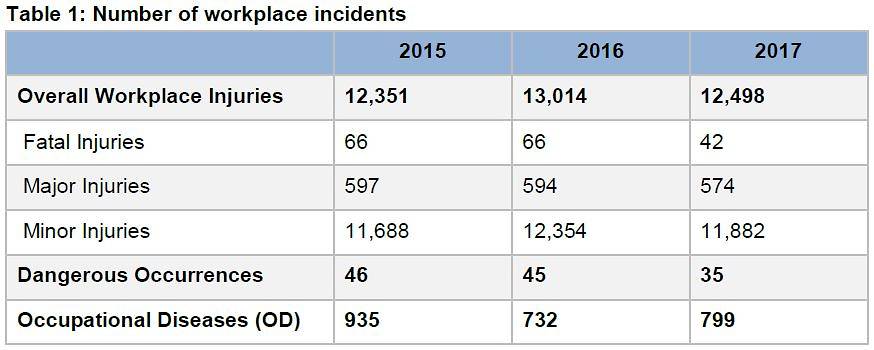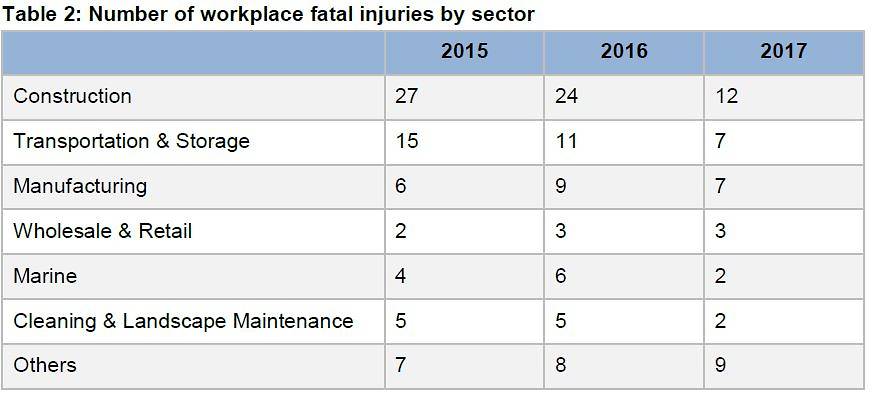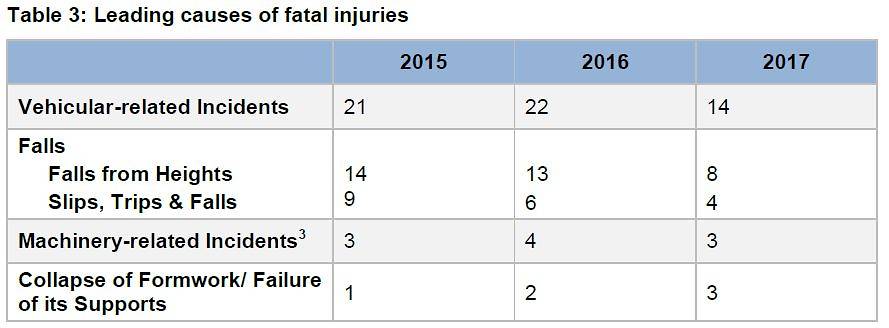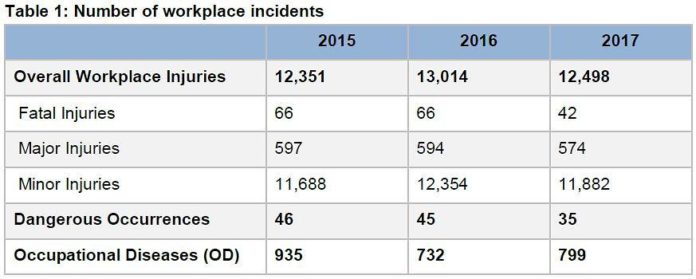SINGAPORE: The workplace fatality rate in Singapore last year was the lowest since 2004, according to a joint press release by the Workplace Safety and Health (WSH) Council, WSH Institute and Ministry of Manpower (MOM) on Tuesday (Feb 13).
There were 42 workplace fatalities last year, down from 66 in 2016, resulting in a fatal injury rate of 1.2 per 100,000 employed persons. This was a “significant improvement after fatal injury rates stagnated at 1.9 per 100,000 employed persons in 2015 and 2016”, the agencies said.

The number of workplace incidents that occurred in Singapore between 2015 and 2017. (Photo: WSH Council, WSH Institute, MOM)
The 2017 rate also met the target set under the WSH2018 Plan, which was to have a workplace injury rate of less than 1.8 per 100,000 employed persons, they added.
The figure was the lowest since 2004, which is the earliest year fatality rate data is available on a comparable basis.

Fatal injuries dropped across the different sectors, including construction, and cleaning and landscape maintenance. (Photo: WSH Council, WSH Institute, MOM)
According to the press release, there were also fewer workplace injuries and dangerous occurrences last year, compared to the year before.
Fatal injuries dropped across the different sectors including construction, transportation and storage, manufacturing, marine, as well as cleaning and landscape maintenance.
While vehicular-related incidents, falls and machinery-related incidents remained the top causes of fatal injuries in 2017, the number of these cases also declined to 29 as compared to 45 to 2016.
Such incidents were also “key contributors to major injuries”, the agencies said, adding that “MOM will continue to focus on the reduction of vehicular incidents, falls and machinery incidents as priority areas in 2018”.

Vehicular-related incidents remained the top causes of workplace fatalities in 2017. (Photo: WSH Council, WSH Institute, MOM)
The number of occupational diseases jumped from 732 cases in 2016 to 799 in 2017. This increase was “driven by the higher number of work-related musculoskeletal disorders (WRMSD) , noise-induced deafness and occupational skin diseases incidents” (NID).
According to the press release, MOM will be enhancing its targeted programmes to prevent the occurrences of these occupational diseases. Efforts include the reduction of excessive noise at source, improving ergonomics and strengthening the management of hazardous chemicals at workplaces.
Commenting on the higher number of occupational diseases, WSH Institute executive director Dr Gan Siok Lin said: “There is a need to manage workplace health the same way we manage workplace safety. Health affects safety and vice versa, so companies should take an integrated approach to enhance both their safety and health management capabilities.”
The press release stated that about 16,000 inspections were conducted in 2017. During the year, 71 stop-work orders, more than 1,200 fines and more than 9,000 notices of non-compliance were issued. This pace of enforcement operations and engagement will sustain in 2018, it said.
While the overall “outcome is encouraging, we must not be complacent”, said WSH Council general manager Patrick Han.
In a blog post published on Tuesday afternoon, NTUC’s WSH director Melvin Yong wrote that while the latest fatality rate is encouraging, new plans are needed to make “the next quantum leap”.
“It is certainly encouraging that the sustained collective efforts by our tripartite partners to tackle workplace fatalities have borne some fruit,” said Mr Yong. “But while workplace fatalities have decreased, major workplace accidents have not.”
Additionally, for Singapore to achieve Prime Minister Lee Hsien Loong’s fatality rate target of a 1.0 per 100,000 workers by 2028, “new strategies and action plans” are needed.
In his blog post, Mr Yong suggested that it be made compulsory for companies to appoint a WSH representative as part of the certification for BizSAFE Level 3.
He also proposed that the Return-to-Work (RTW) programme grant be extended to non-SMEs to “promote and deepen” the RTW culture, and for the grant to cover vocational rehabilitation.





